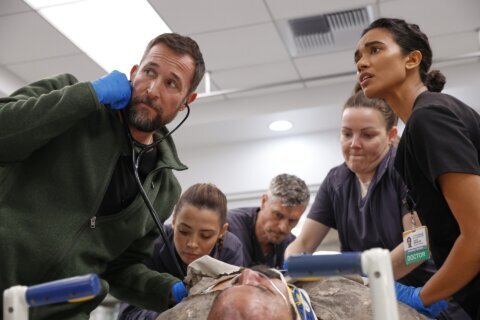WASHINGTON — Just because you can’t physically see the stage, doesn’t mean that you can’t enjoy live theater in the nation’s capital. Sometimes, “theater of the mind” is just as exciting.
For 38 years, Metropolitan Washington Ear has assisted visually impaired theatergoers by providing audio descriptions of the action, costumes, sets and lighting via audience headsets.
“Our late founder, Dr. Margaret Rockwell Pfanstiehl, and her late husband, Cody Pfanstiehl, actually developed the art and technique,” Executive Director Neely Oplinger told WTOP. “This came in response to a request … from the house manager at Arena Stage, who had received a grant to make the theater’s productions accessible for those who are visually impaired. The first audio-described play took place at Arena Stage in Washington, D.C. in October 1981.”
Based in Silver Spring, Maryland, Washington Ear provides the service for nine local theaters: Arena Stage, Ford’s Theatre, National Theatre, Olney Theatre Center, Round House Theatre, Shakespeare Theatre, Studio Theatre, Hexagon, Washington Revels and others by request.
Twenty-one volunteers are specially trained to cover 50 to 60 live shows each season. The oldest volunteer has participated since 1981, while others have over 25 years of experience.
“My first show was ‘A Christmas Carol’ at Ford’s,” volunteer Rita Tehan told WTOP. “The first time it’s just very scary, because in the beginning you do step on actors’ lines. There’s no way to avoid it. … Oddly enough, it doesn’t really get easier. I’ve learned a lot over the years, but because every show is different and because it’s live, you have to be on your toes every time.”
The process starts when blind patrons are handed a headset as they enter the theater. A prerecorded message provides an audio description of the program notes similar to a Playbill.
“There’s two people for every production,” Tehan said. “There’s the describer who shows up and does it live, then there’s somebody who writes what’s called ‘program notes,’ which are prerecorded. They describe the sets and the costumes, so the patron can listen before the show or at intermission. … Plus, background information on the play or musical, information about the creative team and the cast. Usually, it’s about 10 minutes worth of information.”
Once the lights go down and the show starts, where does the audio describer stand?
“For most theaters, there’s a booth with the sound or lighting folks, but there are a couple of theaters, like Arena’s Fichandler, where I’m in the back row of the balcony,” Tehan said. “I wear a mask over my face, so that [the] people sitting in front of or next to me don’t hear me. … If you’ve ever seen a court stenographer, the old-fashioned steno masks, that’s what we use.”
From there, she begins her live narration, describing what she sees in between dialogue.
“I describe what’s going on onstage,” Tehan said. “Any action the performers are doing, any [facial] expressions. I cannot speak when the performers are speaking, so I have to be able to say what I’ve got to say in between [dialogue]. … You have to get in quick because somebody else is going to say something. It’s hard to be succinct. … You have to use a lot of verbs.”
In order to identify these precise moments, Tehan does her homework ahead of time.
“We always see a show twice before it’s described,” Tehan said. “Each time I take notes in a notebook. I take note of the things I need to remember to describe.”
The task is particularly challenging during musicals, such as “Anything Goes” at Arena Stage.
“Usually in a musical, the song starts and then they repeat the chorus, so when the song is starting and the lyrics are fresh, I wouldn’t be talking then,” Tehan said. “When they start repeating the whole thing again, which frequently they do in a song, then I would step in and describe what they’re doing. Frequently in musicals, there’s just music, no singing at all, and I have to describe the dancing, which takes some [doing]. You’ve gotta be on your toes.”
How does she describe the rapid movements of the dance numbers?
“With dancing in particular, I don’t have an advanced vocabulary,” Tehan said. “The most jargon I would say would be like ‘pirouette.’ I would probably just say ‘spin.’ I would never assume that a blind person would know the jargon anyhow, so it’s ‘spinning’ or ‘popping’ or ‘sashaying.’ I might say it’s a waltz step, depending how fast the music is going. They can hear the tapping … but if they’re all spinning, shuffling or pointing, that’s what you would describe.”
It’s a different animal entirely for a nonmusical play, such as “Indecent” at Arena Stage.
“I get detailed, but I don’t cover the blocking too much,” Tehan said. “What’s important is if anyone is trying to hide anything. Anything the blind person needs to know happened in order for it to make sense. Also, they want to know who’s on stage, who’s left, because if somebody leaves, you don’t necessarily hear or notice it. They want to know who’s on stage.”
Her character descriptions also include symbolic interactions without editorializing.
“You’d be surprised how many times characters have their backs to each other — and that’s significant — so I always say that,” Tehan said. “I don’t say the person is mad. I was taught years ago that we don’t say what we think the emotion is; we describe what they’re doing. I would say, ‘The jaw is clenched, the brow is furrowed, he’s making a fist,’ that kind of thing. … That’s a lot of description for one word ‘mad,’ but that’s how we do it, so I get in what I can.”
If you’d like to attend a show, check out the accessibility options on each theater’s website.
“All of the accessibility options are frequently in the same place on a website,” Tehan said. “Our service is called ‘audio description,’ as opposed to ‘sign language interpretation,’ which is for the deaf. Depending on the theater, it’s one or two performances per run. Ford’s Theatre has two performances, while Arena and National and Shakespeare typically just have one.”
Some theaters also provide Braille programs, which has become common practice since the Americans with Disabilities Act of 1990. Signed by late President George H.W. Bush, the law requires public accommodations for people with disabilities. Audio description is not legally required, but many theaters provide it in good faith, just as Arlington Players recently cast a deaf Quasimodo in its fall sign-language production of “The Hunchback of Notre Dame.”
“Believe it or not,” Tehan said, “I had a big turnout for Marcel Marceau the mime.”
Learn more about Washington Ear here. Listen to our full chat with volunteer Rita Tehan below:








